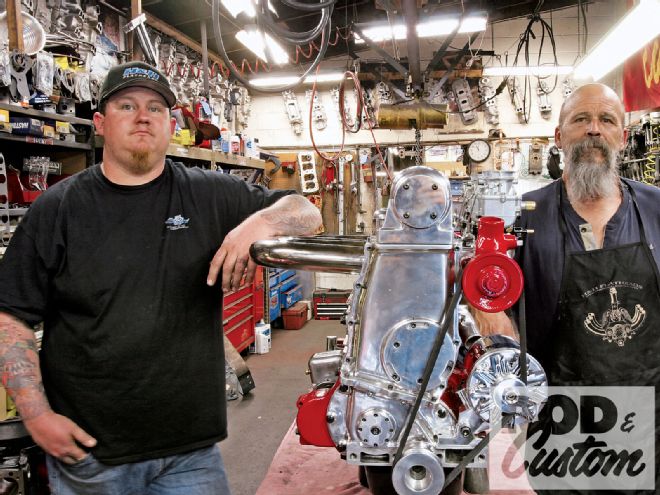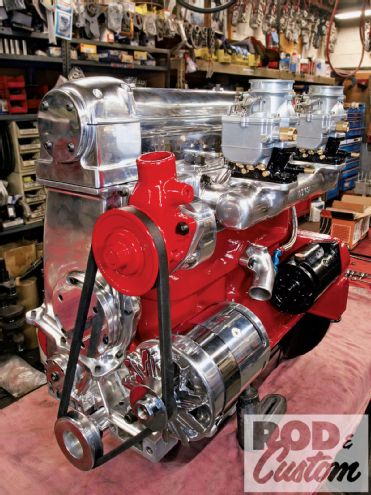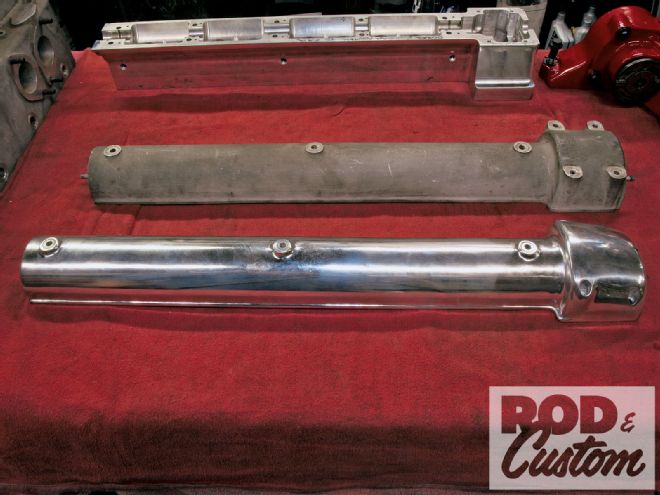
You want to talk about traditional hot rods? Let's talk about four-bangers.
Even before Henry's breakthrough V-8s, and decades before the introduction of the Chevy small-block, these were the prevalent powerplants. Even after the Flathead V-8 was introduced in 1932, four-bangers retained their popularity. One reason is the fact that a lot of development work had already been done, and a lot of speed equipment had already been created to make the four-bangers fast. A four-cylinder with an overhead conversion could be built to make cubic inches and horsepower that the V-8s had a hard time matching.
 H&H Flatheads built this Gemsa-inspired Donovan block four-banger with a chain-driven single-overhead cam conversion, following the way Joe Gemsa did it. They used lots of original parts and lots of fabricated parts too. The engine was delivered to Roy Brizio Street Rods where it was dropped into a project hot rod owned by John Mumford.
H&H Flatheads built this Gemsa-inspired Donovan block four-banger with a chain-driven single-overhead cam conversion, following the way Joe Gemsa did it. They used lots of original parts and lots of fabricated parts too. The engine was delivered to Roy Brizio Street Rods where it was dropped into a project hot rod owned by John Mumford.
That changed eventually, but a few rodders never lost their devotion to 'bangers. Joe Gemsa was one of them. Gemsa was a champion Sprint car driver in the '40s and '50s, built and raced cars in NASCAR, and was one of the best at pulling performance out of four-bangers with his single- and dual-overhead cam conversions. Joe passed away in 1995 and four-bangers have become something of a niche in the hobby, but they still have a high cool factor and a high potential for making power.
If Joe Gemsa was "King of the Four-Bangers," then the Hermans at H&H Flatheads are next in line of succession. Max Herman Sr. opened H&H in 1972. Since then, his sons Max Jr. and Mike have joined him, continuing to build flatheads and flathead parts for extracting maximum performance.
And guess who taught Max Sr. how to build engines? "Joe taught me how to build these four-bangers to make them go fast," he says. "Everything he built was about going fast. There was nothing slow about anything he ever fired up."
Gemsa built engines and parts in a 20-foot refrigerator car behind his house in El Monte, California. "At the end of the refrigerator car he had a small lathe," Max Sr. says. "He made everything on that-pistons, rods, cranks-everything. He had a drill press, his work table, a tiny mill, and a welder. That was his entire shop. His mill work was incredible, and he could weld cardboard to tinfoil. It was amazing to watch him."
The four-banger knowledge that Gemsa passed on to Max Sr. has been passed on to Max Jr., who is the four-banger performance specialist at H&H. We were there when they put together this SOHC 'banger.
 The cam saddle for this engine was based on Joe Gemsa's design. The original Gemsa cast parts are shown next to the custom billet parts, which were modified by H&H.
The cam saddle for this engine was based on Joe Gemsa's design. The original Gemsa cast parts are shown next to the custom billet parts, which were modified by H&H.
The whole thing starts with a Donovan aluminum block with five main bearings. Internals include splayed main caps, a billet steel crank, forged steel rods, Arias custom pistons, Total Seal rings, and hardened steel sleeves. "It will probably make over 200 hp-and it'll be capable of driving every day if you want," Max Sr. says.
The billet cam tower was based on originals cast by Gemsa. "This isn't just a standard-style overhead," Max Sr. says. "It's running an overhead cam chain drive, which is pretty old school. The old Offys and DOHC HALs and others were chain driven. That's one of the ways they made horsepower back then." At H&H, it's one of the ways they make horsepower now.